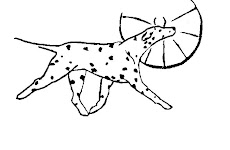
Girls (plus one boy) in the Incubator
Here are some pictures of the little boys eating while their chunky sisters wait in the incubator. Everyone is getting weighed in the morning, the girls weighing a little over a pound each, the boys a little under. It is a case of the bigger puppies pushing the littler ones off the prize nipples. With a little help like this the boys will soon catch up and be able to hold their own. Of course, once the toys come into play, the girls will probably start bossing those boys around again!
And Linda has also started doing the Early Stimulation Exercises For Puppies -
from Breeding Better Dogs by Dr. Carmen Bagittalia
The Importance Of Early Stimulation And Socialization
The U.S. Military, as part of their canine program, developed a method to improve the performance of dogs used for military purposes. This program, initially named "Bio Sensor", is now commonly referred to by the public as the "Super Dog" Program. Based on years of research, the military learned that early neurological stimulation exercises could have important and lasting effects on dogs. Their studies confirmed that there are specific time periods early in life when neurological stimulation has optimum results. The first period involves a window of time that begins at the third day of life and lasts until the sixteenth day. It is believed that because this interval of time is a period of rapid neurological growth and development, and therefore is of great importance.
These simple exercises do not replace routinely handling and playing with each pup, however, they are designed to stimulate the neurological system.
These exercises impact the neurological system by kicking it into action earlier than would be normally expected. The result being an increased capacity that later will help to make the difference in its performance. Benefits observed in dogs exposed to this stimulation were improved cardio vascular performance, stronger heart beats, higher tolerance to stress and greater resistance to disease.
Stimulated pups were found to be more active and more exploratory than their non-stimulated litter mates over which they were dominant in competitive situations. They seemed less disturbed or upset by test conditions and when comparisons were made, the stimulated littermates were calmer, made fewer errors and gave only an occasional distress when stressed.
Additionally, socialization of each puppy is critical in the early development for a puppy. Pups that are handled early and on a regular basis, generally do not become hand shy as adults. During their first two months of life, exposure to children, people, toys and animals on a regular basis, as well as handling and touching all parts of their anatomy is also necessary to ensure appropriate development.
The workouts require handling them one at a time while performing a series of five exercises. Listed in order of preference, the handler starts with one pup and stimulates it using each of the five exercises. The handler completes the series from beginning to end before starting with the next pup.
The handling of each pup once per day involves the following exercises:
- Tactical stimulation (between toes): Holding the pup in one hand, the handler gently stimulates (tickles) the pup between the toes on any one foot using a Q-tip. It is not necessary to see that the pup is feeling the tickle.
- Head held erect: Using both hands, the pup is held perpendicular to the ground, (straight up), so that its head is directly above its tail. This is an upwards position.
- Head pointed down: Holding the pup firmly with both hands the head is reversed and is pointed downward so that it is pointing towards the ground.
- Supine position: Hold the pup so that its back is resting in the palm of both hands with its muzzle facing the ceiling. The pup while on its back is allowed to sleep.
- Thermal stimulation: Use a damp towel that has been cooled in a refrigerator for at least five minutes. Place the pup on the towel, feet down. Do not restrain it from moving.
These five exercises will produce neurological simulations, none of which naturally occur during this early period of life. Experience shows that sometimes pups will resist these exercises, others will appear unconcerned. In either case a caution is offered to those who plan to use them.
In tests of learning, stimulated pups were found to be more active and were more exploratory than their non- stimulated litter mates over which they were dominant in competitive situations.
Secondary effects were also noted regarding test performance. In simple problem solving tests using detours in a maze, the non-stimulated pups became extremely aroused, whined a great deal, and made many errors. Their stimulated litter mates were less disturbed or upset by test conditions and when comparisons were made, the stimulated litter mates were more calm in the test environment, made fewer errors and gave only an occasional distress sound when stressed.



No comments:
Post a Comment